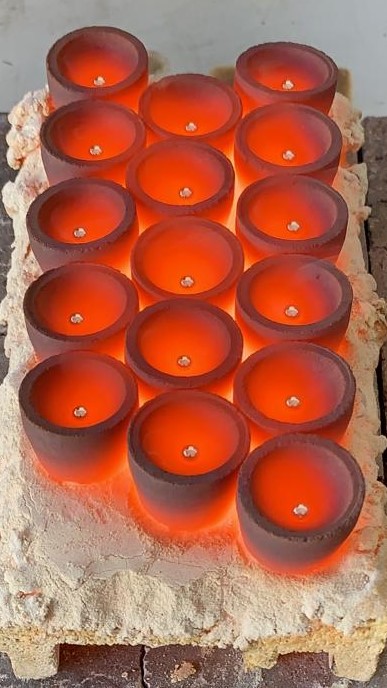
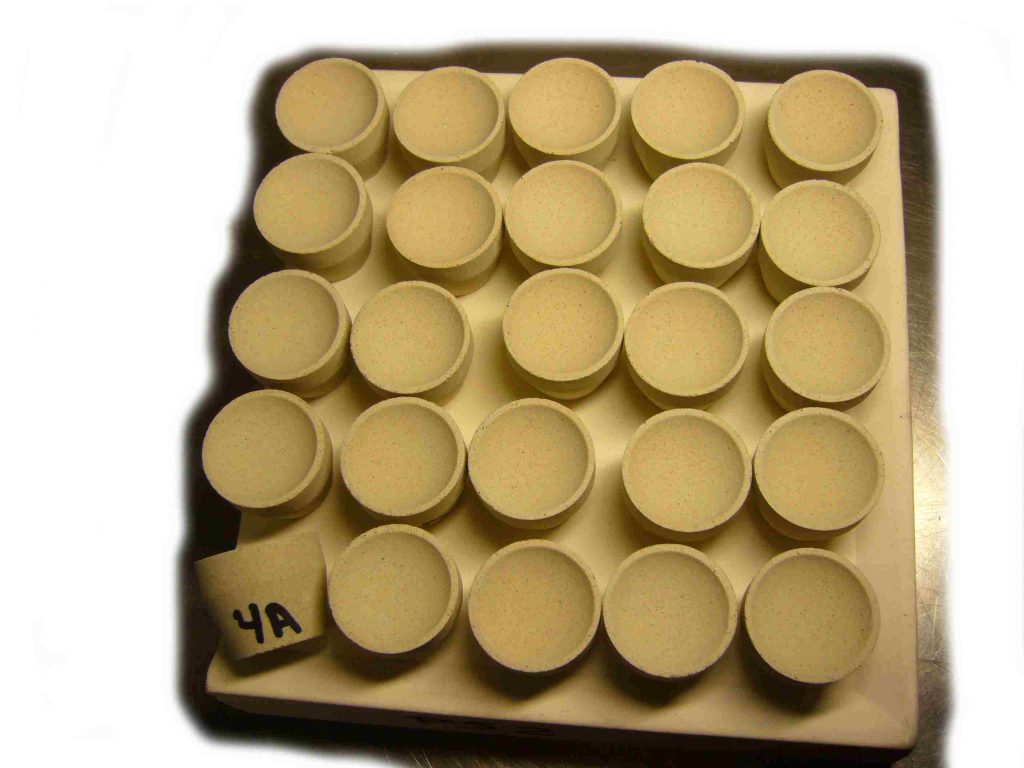
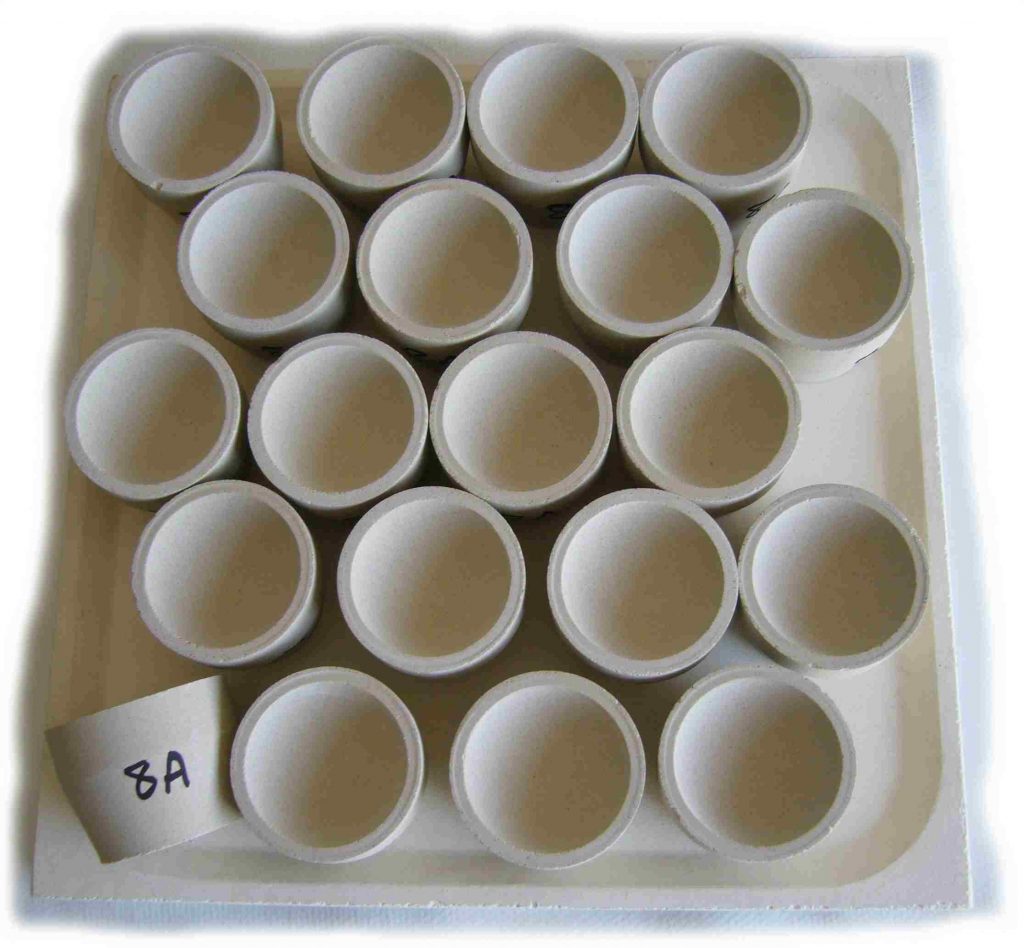
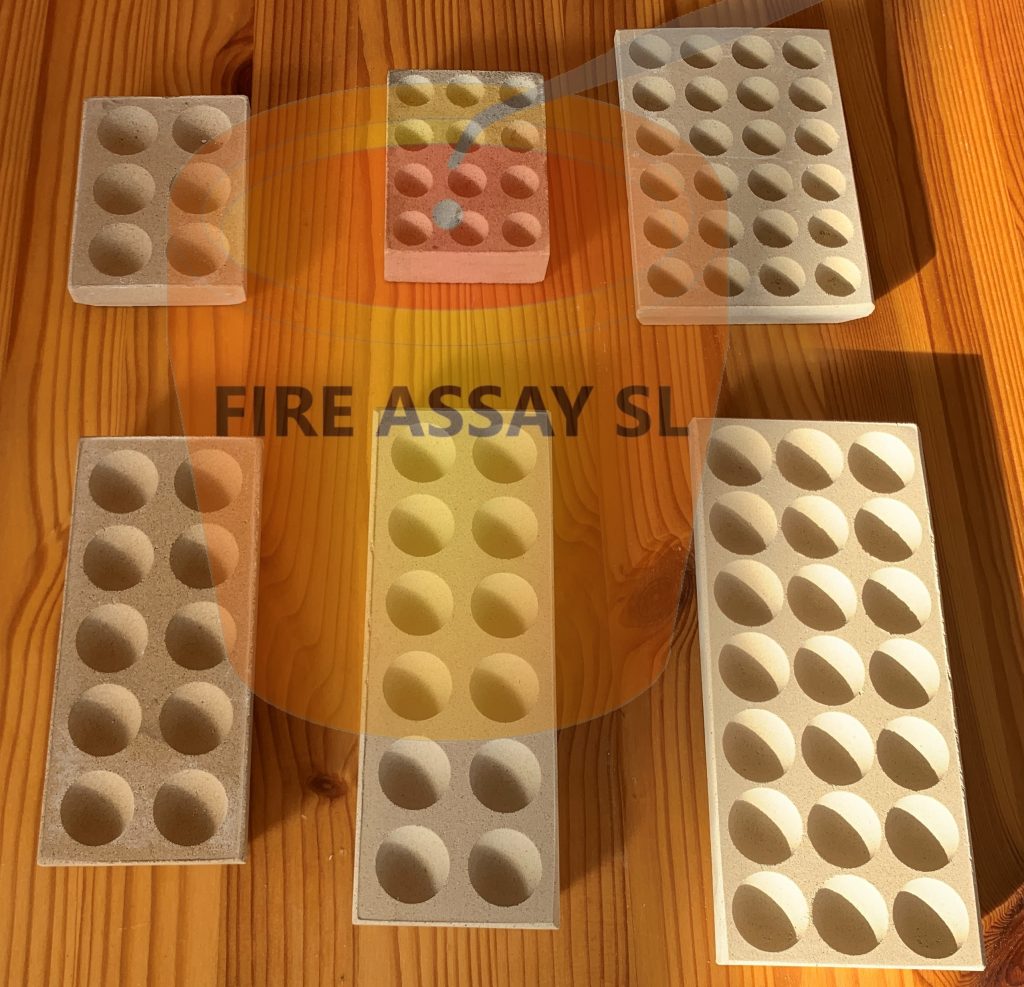
MAGNESIA CUPELS & MAGNESIA BULLION BLOCKS
High quality magnesite is the majoritary component of MABOR magnesia cupels.
MABOR magnesia cupels have a superior quality and offer many advantages:
- Great mechanical strength, and are not affected by atmospheric conditions (not hygroscopic). .
- The prill or bead does not adhere to the fire assay cupel surface,
- When using MABOR magnesia cupels, the assay have a reduced tendency to freeze.
- No cracking or spiting, and the beads do not attach to the fire assay cupel surface.
- MABOR magnesia cupels provide security and quickly absorb great amounts of litharge without cracking or pitting.
- Our magnesia cupels allow to reduce the Cupellation temperature and time, resulting in minimal losses, higher accuracy and better yields.
- Perfect uniformity of Quality of MABOR magnesia cupels
- Quality and performance are continuously improved
MABOR magnesia cupels swiftly absorb 70% of their weight in litharge (PbO) at 980ºC wihtout leaking.
- Cupel trays
- Tongs and tools to hanfle the cupels or blocks
- Multiloaders to load the assay on the cupels or blocks
- Assay grade lead foil and tablets, copper inquarts and silver inquarts
- Accessories for parting and annealing, including quartz baskets
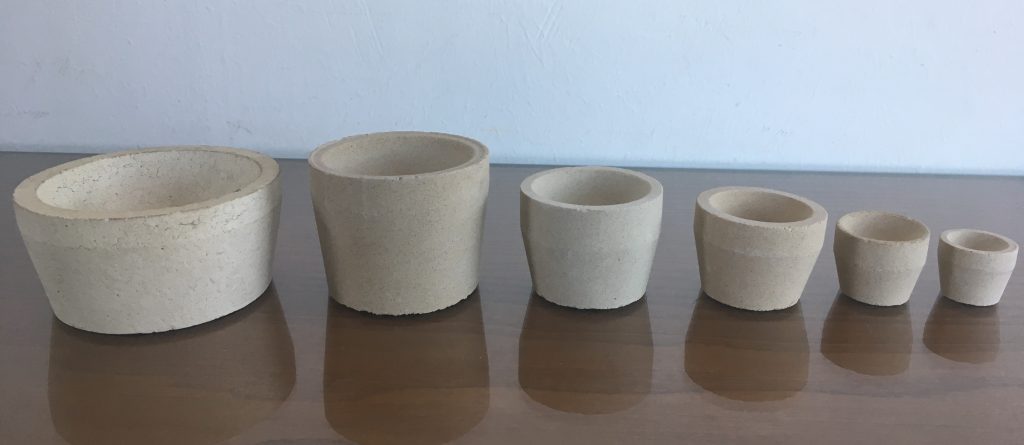
MABOR MAGNESIA CUPELS (MgO Cupels)
Magnesia Cupels 1, 2X, 3, 4, 5 and 6 application is to analyse gold and silver alloys. In this case, it is first necessary to wrap the sample and silver inquarts with assay lead foil or with assay lead tablets. Cupels 1 and 2X are specially suitable for silver analysis and microcupellation. On the other hand, Cupels 3, 4, 5 and 6 are for the analysis of bullion, white gold, and yellow alloys.
Mabor Magnesia Cupels ranging from #7A to #12 use is to analyse ores, ashes, sweeps, scraps, concentrates or electrolytic slimes.
Finally, magnesia cupels 14, 15 and PC are production cupels. They are particularly useful, if the user does not wish to invest in a gold refinery but needs to accasionally produce gold & silver.
MABOR BULION BLOCKS
The absorption capacity of the magnesia bullion is about 8g of litharge (PbO) per hole. The magnesia bullion blocks are particularly useful when the samples have similar gold contents because they allow to:
- Fully exploit Fire Assay‘s parallel processing capabilities
- Fully scale to mass analysis production stage
- Use the Same block for Samples, duplicates, standards & blanks
- High accuracy – samples undergo equal ambient conditions
- Save time – reduce manipulation hazards
- Better stability thanks to their larger base
- Reduce misplacing errors as assays keep the original array
- Ideal for mass analysis of same carat alloy samples
- Handling several bevelled blocks at once
- Usually, it is possible to combine the use of bullion blocks with parting and annealing baskets. If possible, the assayer will save greats amounts of time and nitric acid.
| Size | Cupel Diameter (mm) | Cupel Height (mm) | Cupel Weight (g) | Abs. Cap. @ 980ºC (g) |
|---|---|---|---|---|
| 1T | 22 | 21 | 16 | 11.2 |
| 2X | 24 | 16.3 | 13 | 9.1 |
| 3 | 26.3 | 17 | 16.5 | 11.5 |
| 4 | 30.4 | 18.2 | 20 | 14 |
| 4A | 27 | 22 | 22 | 15.4 |
| PM | 27 | 24 | 27.5 | 19.2 |
| 5 | 31.6 | 19.7 | 24.5 | 17.1 |
| 6 | 36.3 | 21.2 | 37.5 | 26.2 |
| 6A | 40 | 25.4 | 50 | 35 |
| 7A | 39.7 | 28.5 | 59 | 41.3 |
| 7X | 39.7 | 35 | 76 | 53.2 |
| 8A | 45.3 | 35 | 100.5 | 70.3 |
| 8S | 44 | 40 | 107 | 74.9 |
| 9C | 51 | 33.5 | 126 | 88.2 |
| 10 | 60 | 30.2 | 148.5 | 104 |
| 11 | 56.8 | 44 | 197 | 138 |
| 11A | 56.8 | 44 | 190 | 133 |
| 12 | 80.2 | 47 | 443 | 310 |
| 14 | 110 | 70 | 1187 | 831 |
| 15 | 150 | 130 | 4725 | 3.3 kg |
| PC | 254 | 161.6 | 16 kg | 11.2 kg |
| Size | Edge | Length (mm) | Width (mm) | Height (mm) | Hole diam. (mm) | Weight (g) | Picture | Tooling |
|---|---|---|---|---|---|---|---|---|
| 4 HB | Square | 48 | 48 | 20 | 18 | 97 | 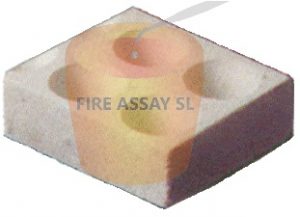 | BS4 |
| 4 SAHB | Square | 80 | 80 | 26 | 30 | 321 |  | BS12 |
| 12 HB | Square | 80 | 60 | 20 | 14 | 204 |  | BS12 |
| 14 HB | Square | 179 | 54 | 20 | 20 | 367 |  | BS14 |
| 6 HB T | Bevel | 81.5 | 60 | 20 | 22 | 184 | 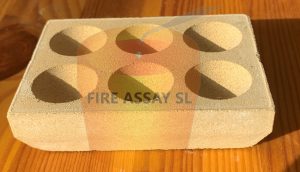 | TF1 |
| 10 HB | Bevel | 138 | 60 | 20 | 22 | 307 | 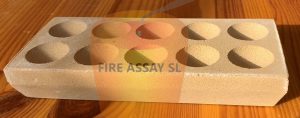 | TF1 / BF10 |
| 12 HB L | Bevel | 165 | 60 | 20 | 22 | 375 |  | TF1 / BF12 |
| 18HB | Square | 147 | 76 | 20 | 22 | 400 | 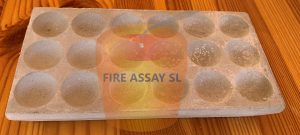 | TF2 / BF18 |
| 21 HB | Square | 172 | 76 | 20 | 22 | 476 | 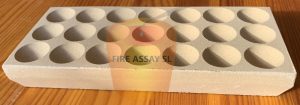 | TF2 / BF21 |
| 24 HB | Square | 124 | 84 | 20 | 16 | 402 |  | – |
HOW TO USE MABOR MAGNESIA CUPELS AND HOW NOT TO
Do not load wet Magnesia Cupels or blocks
If wet, dry cupels before use.
Do not leave Magnesia Cupels dwelling in hot furnace
Cupels are filters that trap litharge, flux, and other metal oxides.
Magnesia Cupels are not refractory fixtures designed to stay long in furnace.
Use Cupels just once
Attemps to reuse magnesia cupels lead to cracking and loss of sample.
No need to preheat Mabor Magnesia Cupels
It is possible to also load cupels warm. However, recommended preheating time is less than 30 minutes. If you want to preheat the cupels we recommend doing it slowly to eliminate any small chance of cracking.
Do not use all the capacity of the Magnesia Cupels
Leave a safety margin to avoid litharge leakages in the furnace.
If you need more capacity, and the furnace has limited space use taller cupels rather than wider cupels.
CUPELLATION PROCESS / CUPELLATION STEPS
Fire Assay cupels were traditionnally used to produce precious metals (gold). However, nowadays, although the production of gold is more industrial, cupels remain the most precise way to determine the precious metal content of a sample.
Fire Assay cupels work as a filter and absorb metal oxides but not metals. When put in ovens at high temperatures whith an oxidizing atmosphere, the cupel absorbs all of the oxidized metals except the precious ones. The unoxidised precious metals remain in the cup of the cupel for weighing or for parting and annealing.
In order for the cupellation process to work, it is necessary to previously mix the sample with lead. For large fire assay cupels, the lead generally comes from a previous reductive fusion done in fire assay crucibles or ashes assay crucibles. However, for smaller cupels and bullion blocks, we wrap the precious metal directly in lead foil.
Cupellation has many easily obervable visual phenomena that help divide the process into the following steps:
- Opening and driving of assay
- Feathers
- Play of colours
- Blick / blinck / brightening / flash / scintillation
Opening and Driving of Assay
The first thing that happens after placing the cupels in the furnace is that the lead melts and a dark layer covers it. Then, the lead begins to oxidise very quickly and the dark layer disappears after only 1 or 2 minutes. As this oxydation is an exothermic reaction, the result is a temperature increase. Because of this, the melted lead becomes bright, and the assay “opens” or “uncovers.”
Once the assay has opened, it is also possible to observe patches of melted litharge circulating on and over it. This gives the assay a glowing and convex appeareance and we say that it is “driving.” (Bugbee p. 92).

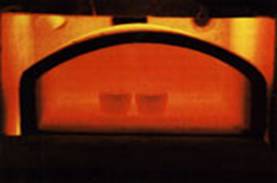
Freezing of Assay and Feathers
Feathers are sublimed crystals of solid litharge that deposit on the edge of the fire assay cupel. When using Magnesia Cupels, the abundance of feathers is an indication that the assay is approaching the freezing point. “Freezing” will happen if the temperature of the assay becomes lower than the melting point of litharge.
As cupellation proceeds and the lead button becomes smaller, the feathers that were initally depositing on the edge of the cupel, start depositing in concentrical rings within the cupel. If these feathers start forming too close to the button, the cupel will not be able absorb any litharge and the button will freeze. Indeed, this solidified litharge covers the liquid lead, protects it from further oxidation, and therefore stops cupellation . Another way to observe the initial stages of freezing, is if the molten litharge on the periphery of the button takes an oily appearance
The results obtained from a “frozen” assay are low, not representative and therefore have to be rejected. However, if we detect “Freezing” on its early stages, and we quickly increase the temperature of the furnace, we might be able to bring the assay to “drive” again.
To prevent the assay from freezing , the temperature has to be high enough to maintain a clear area between the button and the feathers.
According to Bugbee the best results are obtained with a hot start, a cold drive, and a higher heat again at the finish.
Play of Colours
At the end of cupellation, when there is very little litharge left, if forms a thin film on the bead that produces interference colours. We will indeed see rainbow color bands quickly moving on the bead as if it was rotating. This visual phenomena is the “play of colours”. and the larger the bead, the more observable it becomes.
Blick / Blink / Brightening / Flash / Scintillation”
When all the lead is oxidised and the fire assay cupel has absorbed all the litharge the play of colours stops. The bead then takes a normal metallic appearance. This transition is called “brightening” and is usually only observable if the bead is larger than 700mg. When this happens, cupellation is over.
The blick only happens If the bead consists of nearly pure gold and silver, and if it is still liquid but below its melting point (surfusion) . In this case, when the bead continues to cool , it solidifies emitting a flash of light . This visual phenomena is the “blick” or “flash“. The reason for the “blick” is the evacuation of the latent heat of fusion , which raises the temperature considerably during a short moment.
Finally, the absence of blick shows that there are platinum group metals in the sample. However, platinum and palladium do not suppress the blick entirely. (Shepard p. 63)
Spouting / spitting
After cupellation, it is key to slowly cool the bead. Otherwise it will Sprout or spit because liquid silver dissolves greats amounts of oxygen, and violently releases it upon solidification. When spitting occurs, the assays needs to be rejected because loss of precious metals is almost certain.
MAGNESIA CUPELS / BONE ASH CUPELS / CEMENT CUPELS
ABOUT FIRE ASSAY CUPELS
The fire assay cupel is a shallow, porous perfectly smooth cup . There are several material of construction available:
– Bone-ash (absolete and very expensive)
– Portland cement (cheap but poor quality)
– Dead burnt magnesite (magnesia)
– Other refractory and non-corrosive material.
Good fire assay cupels do not crack when heated in furnaces and have enough mechanical strength to withstand handling with tongs.
Furthermore, manufacturing fire assay cupels with an optimal porosity is extremely important . A dense cupel will require longer cupellation times, and higher temperatures: This will result in increased losses of silver. On the other hand, if the cupels are too porous, they can absorb small particles of alloy, also resulting in increased losses of precious metals. (Bugbee p. 89)
Geometry of the fire assay cupel
The shape of the fire assay cupel influences the loss of precious metals. Shallow cupels yield higher loss of silver, and hinder the formation litharge crystals without freezing. The reason is that the bead is exposed to the convective heat of the furnace. It therefore requires higher cupellation temperatures to avoid freezing. T. K. Rose also obtained the same conclusions about shallow cupels. Futhermore, it also seems that shallow cupels have a higher tendency to sprout.
Finally, it is recommended to design the cup of the fire assay cupel so that its volume can bear a weight of lead equal to the weight of the cupel.(Bugbee p. 92 – 93)
ABOUT MAGNESIA CUPELS
One of the advantages of Magnesia cupels compared to bone-ash cupels is that they have a great mechanical strength. They are therefore very easy to transport, and this is one of the reasons why magnesia cupels have gradually substituted bone-ash cupels. (Bugbee p. 116 – 117)
Magnesia cupels behaviour
Magnesia cupels and bone-ash cupels have very different thermal properties. Indeed, Magnesia cupels have a higher heat capacity and thermal conductivity. They are therefore much quicker to evacuate the energy created by the exothermal reaction of the lead oxidation. Because of this, magnesia cupels need higher cupellation temperatures than bone-ash cupels. This is particularly true at the end of the cupellation, when only a small fraction of the lead is still present (1 – 2%).
In terms of absorption capacity:
– Magnesia cupels absorb about two-thirds of their own weight of litharge,
– Cement cupels about three-fourths of their weight of litharge, but the bead sticks to the cupel
CUPELLATION SEQUENCE
| CUPELLATION SEQUENCE FOR SMALL CUPELS (ISO 11426) | CUPELLATION SEQUENCE FOR LARGE CUPELS (ISO 10378) | |
|---|---|---|
| 1. Preheat furnace to 1050ºC 2. Load empty cupels and allow furnace to reach again 1050ºC 3. Allow temperature to reach 1050ºC again | 1. Preheat furnace to 900ºC 2. Load empty cupels and allow furnace to reach again 900ºC 3. Set temperature to 860 ºC (if both Gold and Silver are determined) Set temperture to 900 ºC (if only Gold is determined) | 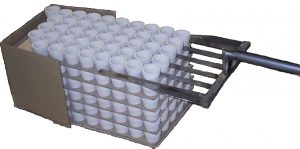 |
| 4. Load Samples 5. Allow temperature to reach 1050ºC again | 4. Load Samples 5. Allow temperature to reach 860 / 900ºC again | 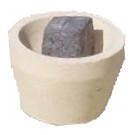 |
| 6. Cupellation Proces Begins, you should observe the following phases / steps: a. If you suspect there is moisture or organic matter preheat to avoid spitting b. The assay uncovers and starts to drive c. Observe for early signs of freezing d. Wait until you oberve the play of colours e. After the play of colours the cupellation process is over |  |
|
| 7. Prevent sprouting by slowly cooling the bead and allowing oxygen to leave | 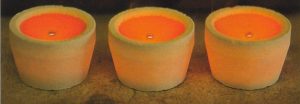 |
|
